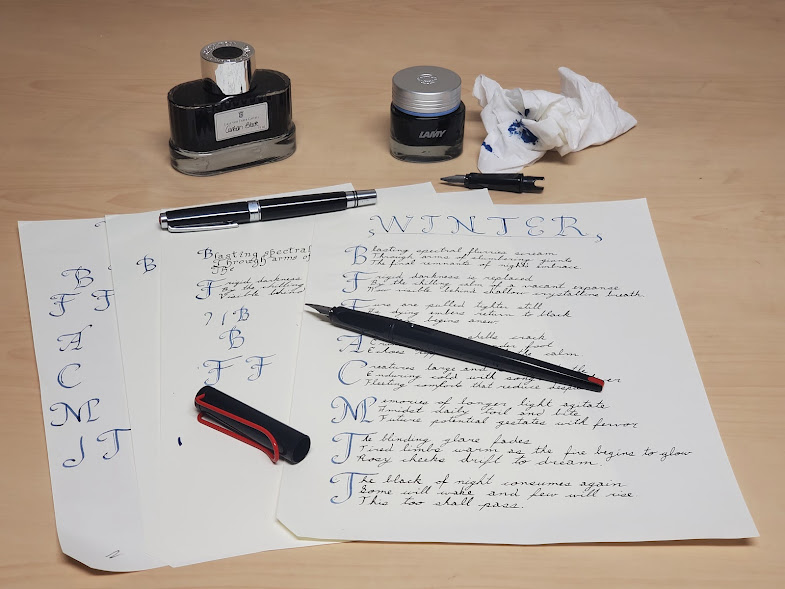Lost Ink

For nearly as long as I can remember I’ve had an interest in calligraphy and fonts. Both of my parents were journeyman typesetters, before that trade was crushed by the digital era, so perhaps there’s something in the blood. My brother and I used to practice by referencing a “beginner’s guide to calligraphy” type book that he had. We also got instruction from my mother, who has a beautiful command of the pen in various styles. At that time, our driving interest stemmed largely from a love of fantasy novels and the related artwork that frequently displayed elaborate text, often embellished with gilding and illumination. There has been fluctuation, as interests tend to go, and there was definitely a lull in my practice of penmanship. Deep immersion in computer use was certainly a contributing factor. For the last several years though I have thankfully come around to a preference and love for calligraphy for journaling, creative writing, and artwork.
Handwriting has understandably been superseded by the keyboard or its equivalent digital inputs for the speed and general utility, among other reasons. The process of decline has been gradual of course. Brush, quill, and dip pens giving way to fountain pens, to ballpoint, to typewriter, and on. The speed and convenience of these new technologies obviously being of preference given the preciousness of time. I recall conversations in which my father expressed his not understanding why anyone would go back to an inkpot and fountain pen after the ballpoint had been introduced en masse. Consider the miracle of a device that writes nearly as smooth as a fountain pen, uses rapidly drying ink that is significantly less prone to smudging (no blotting required), and thanks to its disposable pricing doesn’t require messing about with a pot of ink. Not to mention that fountain pens at that time used unreliable reservoir technology and were likely to leak. It makes sense that we’re now in an age where children likely can’t even read cursive let alone write it because they can type faster with modern means, no pen or ink required.
Despite the sensibility, I now prefer fountain pens and have a growing collection of them. In fact, I am writing the first draft of this with one. While visiting my father recently, I showed him one of my newly acquired pens and said that I’d been using them almost exclusively for my writing. The look he responded with can only be described as perplexed amusement at my foolishness. He gave a quick jot of his signature with the pen and went back to what he was doing without a word. I chuckled as I remembered that he’d spent a large portion of his life with ink stained fingers, by necessity as opposed to choice. He’s earned his distaste in spades.
These days of course, it’s very rare to see anybody with the telltale stains of ink on their hands. It’s sad in a way because the act of writing with this medium forces you to slow down. There is a natural elegance that even the most sloppy writer can experience simply in being forced to form their words with hand crafted effort. While sad in that sense, it’s also beautiful in that ink stained fingers are now a sign of someone who has the same appreciation for the art. What once would have been an every day irritant is now a mark of identification much like cauliflower ear and gnarled knuckles are signs that someone is a grappler. I’m exaggerating the frequency of ink marks, they don't happen as often you might think but the point still stands.
More people could benefit from slowing down what they have to say by handwriting. The computer has given voice to the masses in a way that makes the printing press seem like an infant’s toy. There’s so much to say and do, and time is precious, and there is always more to do. Unfortunately though it seems that most of what people are in a rush to say isn’t worth slowing down to read, let alone write. Perhaps that is the beauty in the death of calligraphy. Not everyone who writes has something interesting or intelligent to say but at least those who take the time to write it out by hand in the age of speed and rapid data consumption are giving their voice a modicum of thought.
I believe that how a person writes - the type of lettering, line accuracy, consistency, evolution of style, the mistakes made, and the attention given - says a lot about them. The simple or elaborate visual appearance with which the ideas are presented are a snapshot of the writer’s presence on the page. When given an appropriate level of attention, calligraphy can even be a simple but elegant display of honour and respect that is sorely lacking in most digital mediums. It can say “these words that I am crafting of my own thought or that I am recreating from a source of admiration, respect, or flattery mean enough to me that in this age of instant gratification and disposable everything, I am willing to slow down and form them with intent.”
Calligraphy may well be considered dead, dying, or useless but the art in it will always remain. Like so many of my interests now, I approach it as an opportunity to improve myself in both presentation of thought and creation of character, personal character that is. Every crossed out line, every smudge, every misshapen letter, or inconsistency is a log of my effort at expressing ideas. They present opportunities to learn, improve, reflect, reconsider, and grow.